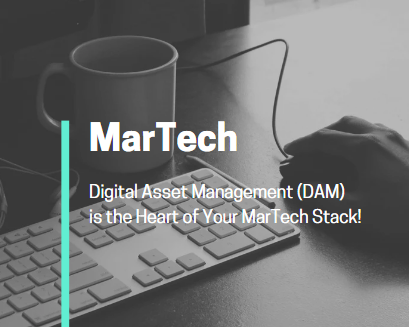How to Build a MarTech Stack from Scratch
The Marketing Process
- Content management
- Marketing automation
- Customer relationship management (CRM)
- Web Analytics
- Digital advertising
- And much more.Prerequisites: Google Analytics with Tag Manager [1,2], Hubspot's free CRM platfrom [3], e-commerce platfrom Shopify [4], and the Wordpress website builder with SEO premium features [5].
DAM Metrics
- Number of Downloads
- Number of Uploads
- Login Frequency
- Asset Requests
- Web Traffic
Customer Lifetime Value
For example, if the CLV of an average coffee shop customer is $1,000 and it costs more than $1,000 to acquire them (via advertising, marketing, offers, etc.) the coffee chain could be losing money unless it pares back its acquisition costs.
The simplest formula for measuring CLV is:
CLV can be measured in the following way:
- Identify the touchpoints where the customer creates the value
- Integrate records to create the customer journey
- Measure revenue at each touchpoint
- Add together over the lifetime of that customer
How to improve CLV:
Invest in customer experience
Ensure your onboarding process is seamless
Start a loyalty program
Recognise and reward your best customers
Provide omnichannel support
Remember the power of social media
Close the loop with unhappy customers
Marketing Experiements
When you invest time, money, and effort into marketing campaigns, you want to get the highest ROI possible. This is where marketing experiments come into play. With marketing experiments, you can test, refine, and apply the results to improve your campaigns and drive results [8,9].
Create a hypothesis
Gather research
Prioritize the proper metrics
Design your marketing experiment
Conduct A/B testing
Analyze the results
Email testing
Pay-per-click (PPC) testing
Social media testing
Usability
Shift your images’ focal point
Play around with design elements
Try out different CTA's
Try animated GIFs
Experiment with words and tone
Target different audiences
Try new time zones
Optimize your content for each platform
Use hashtags
Experiment with mosaics
Regression Analytics
A regression analysis is a way for us to measure the relationship of one variable to another [10]. This allows us to see what factors of our marketing efforts relate to others. Exploring the relationship between different marketing outlooks and actions creates a foundation for eventually testing causality.
Here are some examples of how a regression analysis can be used for marketing purposes:
- Analyze if Social Engagement relates to Pageviews
- Discover whether E-mail Open Rates relate to Conversions
- Learn whether Page Authority relates to Organic Pageviews.
- First, we collect our social media engagement data through the platform’s analytics, such as Facebook Insights and Twitter Analytics.
- Next, we’ll want to export the Pageview data in Google Analytics.
- You can also use the R project or even common spreadsheet software such as MS Excel or Google Spreadsheet.
- The result of regression is represented by two data points (linear trend), R-Squared and the P-Value.
The P-Value is the probability that our hypothesis – a relationship between these two variables – is true. Generally speaking, a p-value below 0.05 indicates statistical significance – our hypothesis has a reasonable chance of being true. Say, we see a p-value of 0.03, indicating statistical significance: our model is mathematically sound.
R-Squared represents how strong the correlation is, on a scale from 0 – 1. Anything above .85 is a strong correlation; the data fits closely to the line the software drew. Anything below .7 indicates very loose or no relationship; while the data and the line are going in the same general direction, it’s too low to draw any useful conclusions.
Content Marketing
Regardless of what type of marketing tactics you use, content marketing should be part of your process, not something separate. Quality content is part of all forms of marketing:
- Social media marketing: Content marketing strategy comes before your social media strategy.
- SEO: Search engines reward businesses that publish quality, consistent content.
- PR: Successful PR strategies should address issues readers care about, not their business.
- PPC: For PPC to work, you need great content behind it.
- Inbound marketing: Content is key to driving inbound traffic and leads.
- Content strategy: Content strategy is part of most content marketing strategies.
Brand Design
- 1. Start With Competitor Research
- 2. Build A Brand That Works In Multiple Mediums
- 3. Less Is More
- 4. Speak To Your Ideal Buyer
- 5. Work To Be Unique
- 6. Establish Standalone Icons AND Typography
- 7. Communicate Your Brand Message
- 8. Keep Things Cohesive
- 9. Establish Clear Brand Guidelines
- 10. Don’t Be Afraid Of Rebranding As Your Company Grows
- 11. Design To Catch The Eye
- Work to implement as many of these guidelines into your branding as possible and you’ll find your end result to be more appealing to your ideal buyer and more effective toward achieving your overall business goals.
Social Media
Social Media Marketing Platforms
- Users: 1.9 billion daily active users worldwide
- Audience: An even spread of Generation X and Millennials
- Industry impact: B2C
- Best for: Brand awareness; advertising
Facebook is the largest social media platform and the most established. Since its launch in 2004, it has become an invaluable tool for B2C businesses, offering advanced advertising tools as well as organic opportunities.
TikTok
- Users: 1 billion active monthly global users
- Audience: Primarily Gen Z followed by Millennials
- Industry impact: B2B and B2C
- Best for: Short-form, creative video content; user-generated content; brand awareness
When you think of short-form video, you probably think of TikTok. The platform rose in popularity in 2020 and shows no signs of slowing down. It's one of the best platforms for community building, with marketers ranking it in second place behind YouTube.
- Users: 1 billion monthly active users
- Audience: Primarily Millennials
- Industry impact: B2C
- Best for: High-quality images and videos; user-generated content; advertising
Although Instagram launched only 12 years ago, the platform has taken the world by storm. When it comes to sharing visually compelling content, Instagram is where brands go. Another thing that sets the platform apart is its advanced ecommerce tools.
Today, users can discover brands, browse their products and/or service, and complete a purchase without ever leaving the app – making Instagram a hard platform to beat.
- Users: 211 million daily active users worldwide
- Audience: Primarily Millennials
- Industry impact: B2B and B2C
- Best for: Public relations; customer service; community building
While Instagram focuses on visuals, Twitter focuses on words. Since the early days of 140-character Tweets, the platform has now expanded to include an audio tool called Twitter Spaces, a community-building tool called Twitter Communities, and Twitter Moments to share interesting content with your followers.
- Users: 774 million active users worldwide
- Audience: Baby boomers, Generation X, and Millennials
- Industry impact: B2B
- Best for: B2B relationships, business development, and social selling
LinkedIn is Facebook's professional cousin. It's perhaps the only platform where its audience is clearly defined: Working professionals looking to network and seek out new opportunities.
That makes it the ideal platform for B2B companies looking to identify key decision-makers and build an industry-specific community.
YouTube
- Users: Over 315 million daily active users worldwide
- Audience: Primarily Millennials but has a strong audience across gender and age demographics
- Industry impact: B2C and B2B
- Best for: Brand awareness; long-form entertainment, and how-to videos
According to HootSuite, YouTube is the second most visited website in the world. In addition, marketers name it the best platform to build community.
In addition to being an incredibly popular platform, its users also tend to stay longer on it because it features mostly long-form content – making it an ideal platform to share educational content.
Snapchat
- Users: 306 million daily active users worldwide
- Audience: Primarily Generation Z
- Industry impact: B2C
- Best for: Brand awareness; advertising
When Snapchat came out in 2011, leading the charge in ephemeral content. It introduced content that you could share with your friends and that would expire after 24 hours.
The platform peaked in 2015 and has held strong since then. Many thought the brand would disappear once Instagram introduced Stories, the same feature with a different name. However, Snapchat continues to be popular among young adults.
- Users: 444 million monthly active users worldwide
- Audience: Primarily Millennials with a solid audience in Gen Z, Gen X and Baby Boomers
- Industry impact: B2C
- Best for: Visual advertising; inspiration
Think of Pinterest like a visual storyboard that allows users to get inspiration for everything from fashion to home decor.
85% of Pinners say Pinterest is where they go to start a new project. In addition, 80% of weekly Pinners say they've discovered a new brand or product on the platform. So, not only is it a great discovery tool but it's also a way for brands to build their narrative through visual stories.
Clubhouse
- Users: 10 million weekly active users worldwide
- Audience: Primarily Millennials
- Industry impact: B2B and B2C
- Best for: Visual advertising; inspiration
Clubhouse made a strong impression as soon as it entered the social media world in 2020. The audio-only platform allows people to start interesting conversations with followers as well as strangers and build community.
The platform also gained some buzz for its invitation-only set up when it was in beta testing. Today, the platform is open to everyone globally and on both IOS and Android devices. Another big selling point to this platform is that it works well for both B2B and B2C businesses and leverages audio, which has made a huge comeback in recent years.
SEO/SEM
· Set site visibility to increase SEO.
· Change permalinks or slugs on a blog.
· Change permalinks or slugs on a web page.
· Insert blog headings to blog using keywords.
· Format an SEO friendly blog heading.
· Add internal links to a blog.
· Add categories and tags to a blog.
· Add Alt Text to images.
· Navigate website analytics.
Blogs & Website
E-Mail Campaign
- Create a Mailchimp account.
- Set your audience.
- Create an email campaign.
- Design and edit your email campaign
- Finish your email campaign design.
- Send your email campaign.
CRM/PM Platfrom
You can manage your customer relationship by using the free HubSpot CRM platfrom. You need to create a Hubspot account and follow a quick demo. It will bring you to the main dashboard.
You can create sales opportunity dashboards, as shown above. This is important for sales managers, sales reps and operations.













Comments
Post a Comment